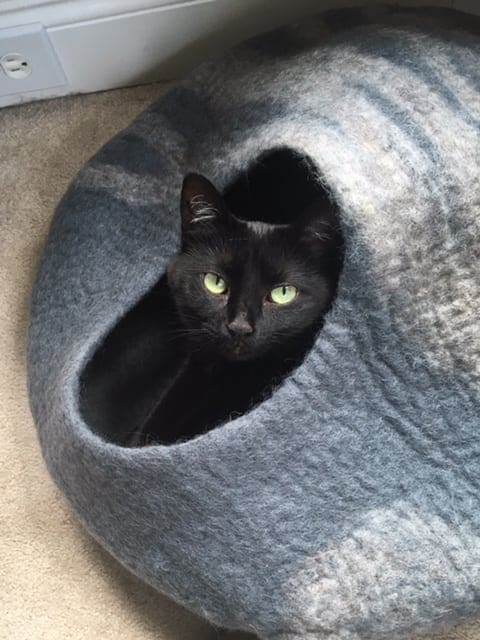
Thunderstorms can be very unsettling. Typically, when it comes to our pets, we think of dogs as the ones who end up shaking, crying, or hiding when Mother Nature displays a sound and light show, but many cats also become nervous. If thunderstorms cause anxiety to your cat, here are nine tips to help you maintain a calm environment during the storm. Keep in mind that it’s normal for a cat to seek out a hiding place during storms but it’s not good if your cat doesn’t recover afterward and feels as if he can’t ever come out into the main part of the home again. If your cat doesn’t return to normal behavior following storms, have a discussion with your veterinarian.
1. Keep Your Cat Indoors
If your cat is normally allowed outdoors and you know a storm has been predicted or is approaching, get him indoors. The most terrifying place to be is right outside in the middle of a storm. For safety, it’s wise to train your cat to come when called. I recommend this for all cats, even indoor ones, but if you let your cat outdoors, it’s crucial. Take the time to teach your cat to respond to his name. Use treats as an easy way to teach a cat to come when called.
2. Be Aware of Your Body Language
If the storm makes you nervous then your cat is likely to pick up on that anxiety. Cats are masters as reading bod language and they know when we aren’t behaving and moving like our normal selves. Be conscious of your movements and do your best to portray a calm demeanor. If your cat wants to be with you, keep your demeanor normal and relaxed. You may even be able to distract your cat with a little playtime but don’t force the issue.
3. Provide Cozy Hideaways for Your Cat
The most comforting place for your cat during a storm may be to remain curled up and hidden. Provide several cozy hideaway options for him. An “A” frame or igloo style bed may provide just the right amount of comfort and security for an anxious cat. Some cats may need more of a hiding place such as a closet. If your cat wants to hide there, provide a little hideaway inside the closet or place a box in there, lined with a towel. If you have some hideaways scattered around the house where you spend the most time, that might encourage your cat to stay in the room with you rather than duck under the bed in a room alone. Hiding is a valuable way cats cope with extreme fear or stress. Don’t try to pull your cat out of a hiding place in order to provide comfort. Never force any kind of interaction. If your cat feels safer being hidden, then provide that option.

4. Block out Noise and Light
Although it’s impossible to block out all of the thunder claps and bright flashes of lightning, try to reduce the effect by placing your cat in a room without windows, or at least make sure drapes or blinds are closed. Play soothing music to help buffer some of the frightening sounds.
5. Pheromone Therapy for Cats
Feliway, a synthetic pheromone product, mimics the calming natural facial pheromones that cats have. Some people find that pheromone therapy works well with their cats but some don’t. If you want to give it a try, you can buy the pheromone diffuser at your local pet product store or online. Synthetic pheromones also come in a spray form and you can spray the cat’s bedding or hiding area about 20 minutes before.
6. Anxiety Wraps
There are calming anxiety wraps available that your cat can wear but as with the pheromone therapy, some cat parents report the wraps work well and others say they have no effect. If you do decide to try an anxiety wrap give your cat time to adjust to it. Put it on your cat with light pressure and then distract with some play. The wrap comes with instructions. Before shopping though, take your cat’s measurements so you’ll buy the right size. Sizing is based on weight and chest size. Some cats don’t react well to the anxiety wraps and either refuse to move or lay down on their sides. Other cats respond almost immediately to the calming effects. Use your judgment on whether the wrap is benefiting your cat or not. One thing to keep in mind is that many anxiety wraps use Velcro closures which can make a very scary sound for the cat when it’s time for removal.
7. Pay Attention to Multicat Interactions
If you have a multicat household, watch for any redirected aggression. It’s possible one cat may get agitated enough to redirect that fear, in the form of aggression, toward a cat companion. If that’s the case, carefully and safely separate the cat in another room to find a place to hide and feel safe.
8. Natural Supplements
If your cat doesn’t calm down during storms no matter what you’ve tried, talk to your veterinarian about whether a natural supplement containing l-theanine would be beneficial.
9. Let Your Cat Decide What is Comforting
Don’t force your cat out from a hiding place or force him to be in your arms. This will just make your cat feel more restrained and terrified. Let kitty determine where he’s more comfortable. Create a calm environment but give your cat the choice of the preferred location. Some cats can be distracted with playtime but others may want nothing more than to curl up in the corner of the closet. If your cat does want comfort, then be there for him and offer affection and reassurance in the way he prefers. Your cat may feel most comforted by being in your lap, or may just want to sit next to you without being petted or touched. Let your cat set the pace on what type of interaction is desired.
Need More Information?
For more specifics on cat training or cat behavior problems, refer to any of the books by Pam Johnson-Bennett. Pam’s books are available at bookstores and online. We’ve included links to Amazon here on our website.
If you have a question regarding your cat’s health, please contact your veterinarian. This article is not intended as a replacement for your cat’s veterinary care.



